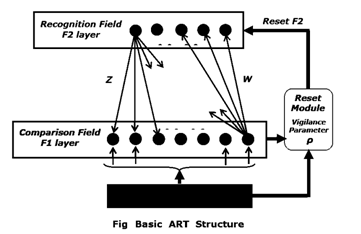SKEDSOFT
Introduction:-An adaptive clustering technique was developed by Carpenter and GrossBerg in 1987 and is called the Adaptive Resonance Theory (ART) .The Adaptive Resonance Theory (ART) networks are self-organizing competitive neural network. ART includes a wide variety of neural networks.
ART networks follow both supervised and unsupervised algorithms.
− The unsupervised ARTs named as ART1, ART2, ART3, . . and are similar to many iterative clustering algorithms where the terms "nearest “and "closer" are modified by introducing the concept of "resonance”. Resonance is just a matter of being within a certain threshold of a second similarity measure.
− The supervised ART algorithms that are named with the suffix "MAP”, as ARTMAP. Here the algorithms cluster both the inputs and targets and associate two sets of clusters.
The basic ART system is unsupervised learning model. It typically consists of
− a comparison field and a recognition field composed of neurons,
− a vigilance parameter, and
− a reset module
Comparison field:-The comparison field takes an input vector (a one-dimensionalarray of values) and transfers it to its best match in the recognitionfield. Its best match is the single neuron whose set of weights(weight vector) most closely matches the input vector.

Recognition field:-Each recognition field neuron, outputs a negative signal proportional tothat neuron's quality of match to the input vector to each of theother recognition field neurons and inhibits their output accordingly. Inthis way the recognition field exhibits lateral inhibition, allowing eachneuron in it to represent a category to which input vectors are classified.
Vigilance parameter:-After the input vector is classified, a reset module compares the strength of the recognition match to a vigilance parameter. The vigilance parameter has considerable influence on the system:
− Higher vigilance produces highly detailed memories (many, fine grained categories), and
− Lower vigilance results in more general memories (fewer, more general categories).
Reset Module:-The reset module compares the strength of the recognition match tothe vigilance parameter.
− If the vigilance threshold is met, then training commences.
− Otherwise, if the match level does not meet the vigilance parameter, then the firing recognition neuron is inhibited until a new input vector is applied;
Training commences only upon completion of a search procedure. In the search procedure, the recognition neurons are disabled one by one by the reset function until the vigilance parameter is satisfied by a recognition match.If no committed recognition neuron's match meets the vigilance threshold, then an uncommitted neuron is committed and adjusted towards matching the input vector.